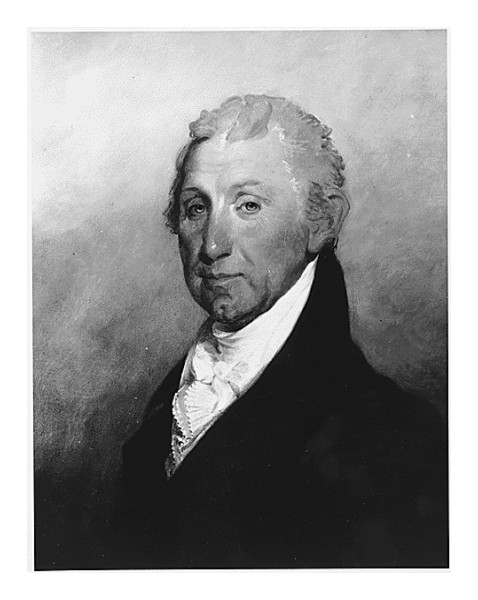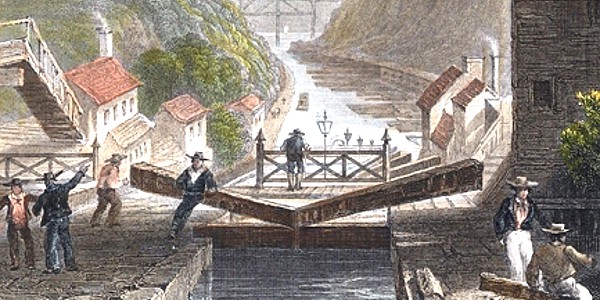
Image above: President James Monroe. Image right: Triumph, depicting eventual victory of Union, with reference to the Missouri Compromise. Created by Morris H. Traubel, 1861. Images courtesy Library of Congress.
Sponsor this page for $75 per year. Your banner or text ad can fill the space above.
Click here to Sponsor the page and how to reserve your ad.
-
Timeline
1823 Detail
April 5, 1823 - Act signed for funding of the creation of the Albany Basin, a man-made port linked to the Erie Canal, in Albany, New York, is appropriated.

Since construction on the Erie Canal had begun on July 4, 1817, and even before, civic leaders in Albany, New York, began discussing just how to take advantage of the business prospects of the transportation route up the Hudson River and traversing the Erie Canal to the Great Lakes. By 1822, it is acknowledged that they began discussing the establishment of an expanded port. Both Albany and Rensselaer, New York, on both sides of the Hudson River, had been ports along the river since the 17th century. Albany (founded 1624 as a trading post) had been the chief market town for the Upper Hudson River Valley since the Dongan Charter established the city in 1686. Three city owned docks, two later expanded into wharves, had been established in 1766. By 1822, use of the port, three years prior to the Erie Canal's completion, would often see eighty to two hundred boats along its shoreline docks.
With the Erie Canal soon to be online, city officials and Canal Commissioners decided that a pier should be built, enclosing thirty-two acres of the Hudson, which is seven hundred feet wide at Albany. It would be known as the Albany Basin. The basin was not unanimously desired; arguments against included use of public money and a general lack of wanting to build basins along the canal. There was even a proposal for a sloop lock at the end of the Erie Canal that would collect tolls there. Some thought that would be sufficient with private docks along the river and canal serving the boats.
But the legislature bought into the Albany Basin idea and authorized. They also authorized the sloop lock. There would be two draw bridges constructed to the mainland at Columbia and State Streets, two hundred and fifty feet across the basin to provide access to the pier. The pier ran four thousand three hundred and twenty-three feet perpendicular to the riverbank and was eighty-five feet wide. It cost $119,980 to build. The basin would be located at the entrance to the Erie Canal and was ready for operation when the canal began taking traffic in 1825 with the first water inside the sloop lock by September 1823.
The Albany Basin could accommodate one thousands canal boats and fifty steamboats at one time. Wharf charges would go half to the Pier Company and half to the state. The pier lots would be auctioned off. One hundred and twenty one sold for $188,510.
Construction was completed by May 27, 1825.
Use and Demise of the Albany Basin
While the initial success of the Albany Basin pier itself was large, the success of the sloop lock was not. It was poorly built, refused to hold water, and was destroyed by 1835. Through the start of the Civil War, the property along the piers was some of the most valuable in the city. There were offices for the various Canal companies (Swiftsure, Albany, and Canal) and warehouses along the riverbank surrounding the basin and Erie Canal. The wharves were filled with lumber and other supplies waiting for transport. Hart and Hoyt built a large raft, named the Ark, to hold their merchandise that waited; it caused a lot of consternation to other companies as it was difficult to navigate around.
The Albany Basin would remain the main port of Albany until 1932, although its decline occurred much earlier when the railroad made its impact. In 1873, warehouses that once rented for up to eight hundred dollars a year now went for down to three hundred; many were empty. By 1879, you could already see that demise was in the future. In 1954, the area of the Albany Basin was filled in, in preparation for construction of I-787.
Image above: Drawing of the Albany Basin, 1857, author unknown. Courtesy Wikipedia Commons. Image below: Engraving of the Erie Canal at Lockport, New York, by W.H. Bartlett, 1839. Courtesy Wikipedia Commons. Source Info: "The Albany Basin" and "The End of the Albany Basin," 2017, Carl Johnson, Hoxsie; Wikipedia Commons.

History
Photo Bomb







